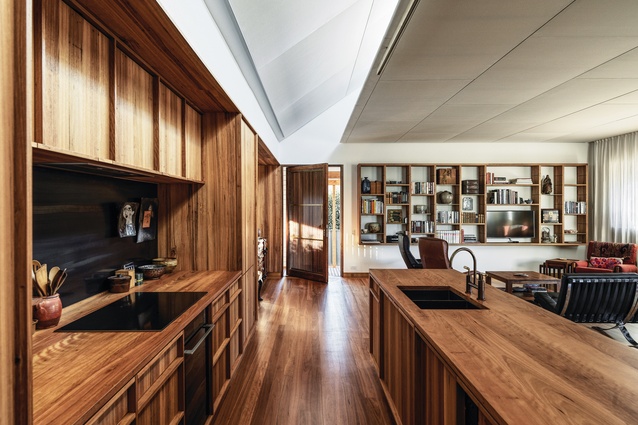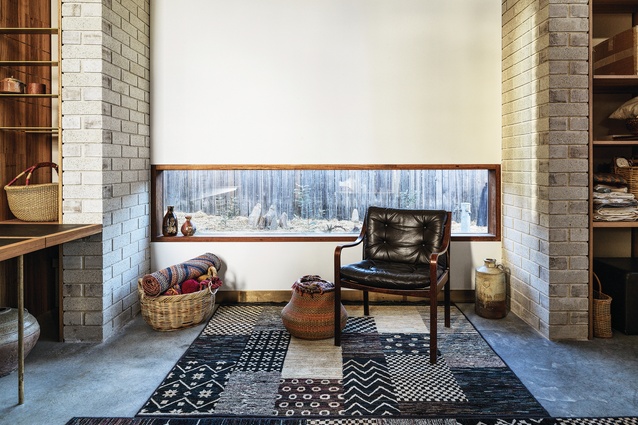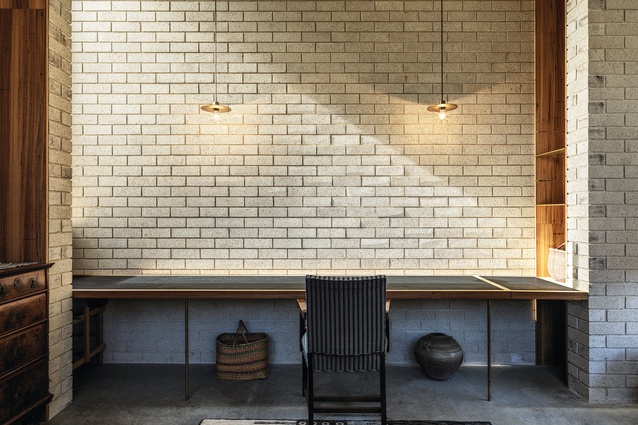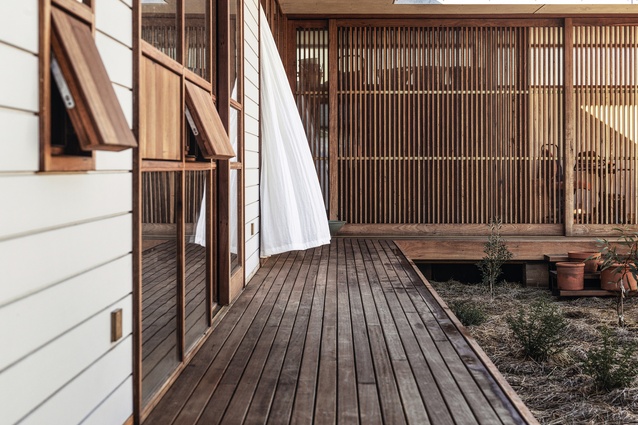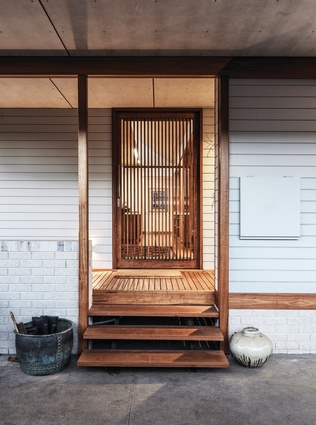Marvellous town life: Cloud Cottage
In the Southern Highlands of New South Wales, a new cottage by Takt Studio shirks polite defensiveness for porosity, contributing generously to its streetscape while also enabling quiet repose.
As you weave through the flat residential grid of streets in Bowral, a town in the Southern Highlands of New South Wales, a pattern emerges. Front gardens are populated with hedges, picket fences, decorative gates, garage doors and, generally, a flowering European tree centred in a very green lawn. These gardens seem to be a polite layer of defence that offers no clues about the private spaces that lie beyond the curtains of the house facades.
Cloud Cottage by Takt Studio is therefore a little disarming on first approach. In place of a front fence, there is instead an array of native plants among several raised white-brick planters. The garden is strewn with damp hay and one or both of the owners can often be found tending to it. The largest of the low brick planters has a flat eave hovering over it and, on approach, is revealed as a porch. Beyond it, a room bathed in light is glimpsed through timber screens. Timber cabinetry is visible, as is the movement of people. From the footpath, it seems as if you can see right into the most domestic of situations.
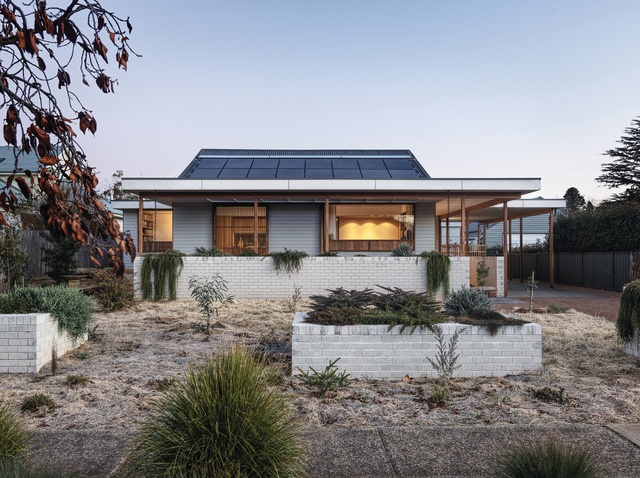
This permeability is just how the owners like it. The street-facing porch and the front room behind it are semi-public rooms in which gathering, cooking and eating are done. The success of the design lies in how it balances these open and welcoming areas with discrete private zones. The front of the house faces north and, in the sometimes-cool climate of Bowral, it makes sense to orient the living areas of this house towards the street. The effective detail of the louvres to the front porch – angled pieces of fibre cement sheet – allows winter sunlight to bathe the deck while the summer sun is precluded.
Takt Studio’s design was initially developed around an existing cottage on the site. However, it became clear in early site stages that the remaining parts of the old house were structurally damaged, and the clients bravely agreed it was sensible to raze the remnants and start the new build from scratch. Externally, only the pitched roof of the new house matches that of the modest former bungalow. But, as the rebuild was agreed to after the contract had commenced on site, the design couldn’t be completely refigured. As a result, the scale of the ancillary rooms and bedrooms has a modesty that echoes the scale of the older cottage.
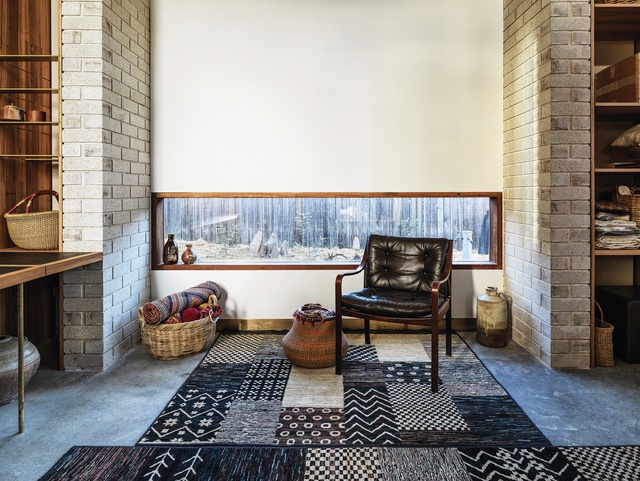
The main entry to the house is from the side, though many people simply wander in via the front porch. The main living space is exceptionally generous and tactile. The ceiling is luminous and is clad in panels of stretched art canvas. These make the whole surface a diffusing layer that tempers daylight from skylights above and, in the evenings, gently spreads the warm glow cast by LED lights. A full-width angled skylight draws light down into the blackbutt timber kitchen.
The same timber species has been used for a long bookshelf on the western wall, which displays objects collected by the owners during their travels. In the dining area, two sliding doors – one glazed, the other a timber screen – connect to the front porch, while a raised sill height in the living area admits sunlight but provides privacy for a reclining resident.
The house is effectively only two rooms deep, with an eastern wing that extends to the rear. A private rear courtyard is framed by this wing, with a storage structure of fibre cement sheet on the western side and an arbour on the southern boundary. The eastern wing has a series of useful yet utterly charming spaces – a small study facing the street, a sunny bathroom with tiles that match exactly the white brick of the internal structure, and a laundry concealed in timber cabinetry. In their detailing, these spaces celebrate the practical tasks of life.

A long and thin ambiguous open room, with a clerestory window in reeded glass, is entirely glazed to the rear courtyard and is therefore only a slightly more enclosed version of the adjacent verandah. The timber-framed glass doors slide back, as does the separate layer of timber-framed brass mesh screens. This space is used variously for exercise, as a dormitory for visiting family, for games or simply as a contemplative space, enhanced by the garden of eucalypts.
Beyond this sunroom, a few steps lead to a room that has almost the quality of a temple. Off-white brick columns frame the corners of the space and a long desk positioned against the brick wall allows a number of different activities to be left and resumed. Clerestory windows distribute toplight evenly. A low window allows another narrow native garden to be contemplated.
For owners who have moved from the open and private freedom of a remote mountaintop eyrie, “town life” could have been an unpleasant shock. Yet this gentle house with a modest footprint uses the entire site and offers a range of public and private spaces. It allows its owners to work separately and to rest as needed, but also to come together for meals, family time and community events. The layers of planters and screens between the front footpath and the main room, and the careful organization of increasingly private and quiet spaces within the house, has created a marvellous place to be.
This article has been republished from architectureau.com.

